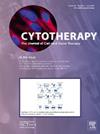同种异体造血干细胞移植使用降低强度调理方案的患者急性髓系白血病未完全缓解。
IF 3.7
3区 医学
Q2 BIOTECHNOLOGY & APPLIED MICROBIOLOGY
引用次数: 0
摘要
背景:同种异体造血干细胞移植(HSCT)是难治性和复发性急性髓性白血病(R/R AML)患者未完全缓解的唯一潜在治疗选择。许多关于未缓解的R/R AML患者预后的研究集中在接受清髓调节方案(MAC)的患者身上。相反,降低强度调节方案(RIC)对于一些患者来说可能是一个相当大的调节方案,因为老年患者中R/R AML的发病率很高,而这些患者不是mac的候选者。目的:本研究旨在评估R/R AML患者接受同种异体HSCT合并RIC的预后和确定与结果相关的因素。研究设计:本研究包括707名接受RIC治疗的未完全缓解的AML成年患者。主要终点是无进展生存期(PFS),使用Kaplan-Meier方法估计。使用Cox比例风险模型确定预后因素,并使用链式方程方法进行多重输入。结果:5年PFS、总生存率、复发率和非复发死亡率分别为18.8%(95%可信区间[CI]: 15.6-22.2)、22.0% (95% CI: 8.5-25.7)、53.6% (95% CI: 49.7-57.4%)和27.5% (95% CI: 24.0-31.2)。多变量分析显示,男性、运动状态差、核型风险和外周血细胞与PFS显著相关。结论:本研究确定了未完全缓解的R/R AML患者的预后因素。这些结果可以帮助制定治疗R/R AML的移植策略。本文章由计算机程序翻译,如有差异,请以英文原文为准。
Allogeneic hematopoietic stem cell transplantation using reduced intensity conditioning regimen for patients with acute myeloid leukemia not in complete remission
Background
Allogeneic hematopoietic stem cell transplantation (HSCT) is the only potentially curative treatment option for patients with refractory and relapsed acute myeloid leukemia (R/R AML) not in complete remission. Many studies investigating the prognosis of patients with R/R AML not in remission focused on patients who received myeloablative conditioning regimen (MAC). Conversely, reduced intensity conditioning regimen (RIC) could be a considerable conditioning regimen for some patients because of the high frequency of R/R AML in older patients who are not candidates for MAC.
Objective
This study aimed to evaluate the prognosis and identify factors associated with outcomes in patients with R/R AML who underwent allogeneic HSCT with RIC.
Study Design
This study included 707 adult patients with AML not in complete remission who had received RIC. The primary endpoint was progression-free survival (PFS), which was estimated using the Kaplan–Meier method. Prognostic factors were identified using a Cox proportional hazards model with multiple imputations using a chained equation approach.
Results
The 5-year PFS, overall survival, relapse, and nonrelapse mortality were 18.8% (95% confidence interval [CI]: 15.6–22.2), 22.0% (95% CI: 8.5–25.7), 53.6% (95% CI 49.7–57.4%) and 27.5% (95% CI: 24.0–31.2), respectively. Multivariable analysis revealed that male sex, poor performance status, karyotype risk, and blasts in the peripheral blood were significantly associated with PFS.
Conclusions
This study identified prognostic factors in patients with R/R AML not in complete remission. These results can help to develop a transplant strategy for the treatment of R/R AML.
求助全文
通过发布文献求助,成功后即可免费获取论文全文。
去求助
来源期刊

Cytotherapy
医学-生物工程与应用微生物
CiteScore
6.30
自引率
4.40%
发文量
683
审稿时长
49 days
期刊介绍:
The journal brings readers the latest developments in the fast moving field of cellular therapy in man. This includes cell therapy for cancer, immune disorders, inherited diseases, tissue repair and regenerative medicine. The journal covers the science, translational development and treatment with variety of cell types including hematopoietic stem cells, immune cells (dendritic cells, NK, cells, T cells, antigen presenting cells) mesenchymal stromal cells, adipose cells, nerve, muscle, vascular and endothelial cells, and induced pluripotential stem cells. We also welcome manuscripts on subcellular derivatives such as exosomes. A specific focus is on translational research that brings cell therapy to the clinic. Cytotherapy publishes original papers, reviews, position papers editorials, commentaries and letters to the editor. We welcome "Protocols in Cytotherapy" bringing standard operating procedure for production specific cell types for clinical use within the reach of the readership.
 求助内容:
求助内容: 应助结果提醒方式:
应助结果提醒方式:


